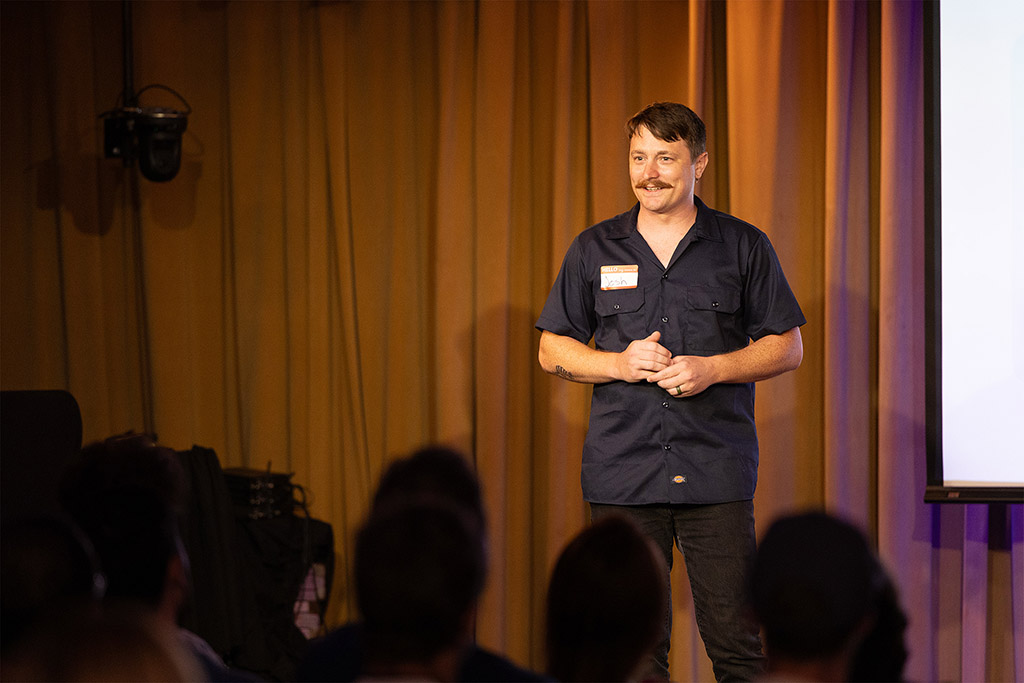Making Beer at Central Machine Works
Transcript
We’re just going to talk about beer. It’s been bringing people together for thousands of years to share stories, information, laughs most importantly. Interestingly, it’s only four core ingredients that go into making it. We’ve got grain, water, hops, and yeast. Let’s talk a little bit about how it’s made and how I’m using what I’ve learned in the brewing industry to build a brewing system at my house that’s going to be my brewing system. This is grain. We get grain from all over the world and crack it open to get the sugar that’s inside. That’s what the yeast is going to turn into alcohol. We put it in what’s called a mash tun, a big metal pot with a screen at the bottom. We stir it in. We let it sit there at a very specific temperature for a while, and we get what’s called wort, a sugary water. It’s not beer yet. We make wort and yeast makes beer.
But we need to separate that wort from what is now spent grain so we let it just gravity go out into another kettle called a grant before we pump it into our main kettle. If we were to try to pump it from the mash tun, it would compact all the grain and lock it up, and we would never get any of it. But once we’re in the kettle, we boil it to drive off any volatile compounds, sterilize the liquid, and most importantly, add our hops. Hops added in the beginning are going to add bitterness while hops added at the end are going to add more of the flavor and aroma. Then we have to drive that temperature down very fast so what we do is we pump hot wort through a heat exchanger with cold water going in the opposite direction, and they exchange that heat and we end up getting our nice cool down wort to go into our fermentor where we add the yeast.
Once we have the yeast in there, we monitor it for about two weeks and pay really close attention to the temperature and make sure the yeast is happy. It’s eating that sugar and it’s turning it into alcohol and CO₂. Then we carbonate it and we package it. Most commonly we do it in kegs because it’s the fewest amount of parts and labor and it goes pretty fast. But sometimes small breweries still like to have a to-go option so we’ll can it even though it’s a lot more materials, a lot more time and labor. If you don’t have an automated canning line, it can be pretty messy as you’re spinning these so you need the proper attire. In this case, a trash bag. But there’s so many ways to move liquid around a brewery in a sanitary fashion.
We’ve got so many parts, elbows, sight glasses, tees, clamps, valves. It kind of feels like you’re playing with Legos again or an erector set and really the limit is your imagination and some engineering principles for sure. But instead of bending down and hooking up hoses to get your hot water and your cold water, you can add a few different parts and some valves. It’s as easy as just turning valves to get water to go wherever you need it throughout the brewery. We can also take, I think it’s 17 different parts to hook up what we call a yeast brink, a yeast storage vessel to a fermentor and when that yeast is done doing what it’s doing, we can harvest it and re-pitch it at a later date to save money.
The crispy boys, those super clear beers, we have to filter them. We push it through a filter. We use a ton of hoses in a tight little wet space and create a snake farm. If you’re already worried about slipping, now you have to worry about tripping on stuff. But getting to use all those parts and do the processes has given me a leg up on brewing at home so instead of using plastic buckets like you’ve seen people use, I’ve been able to focus more on building a system that will transition into being a pilot system for the brewery I’m planning.
I was able to use scaled down parts of the same stuff we use at the brewery to build manifold like this one to move water and wort into this brewery that is on wheels and can move around the garage and make up to 25 gallons of wort or 15 and a half gallons of finished beer, which is a full keg. Just like at the brewery, once it’s done fermenting, we carbonate it right in that tank and I’ll put some in a keg, put it in my kegerator so I have it at home, and the rest goes into bottles to hand out to family, friends, and potential investors if it seems fit, because it’s always nicer to get a bottle of beer than a business card. If you guys want to see what it’s like to open a brewery in Austin, feel free to follow Borrowed Time Brewing on Instagram, Facebook. Cheers guys.


















































